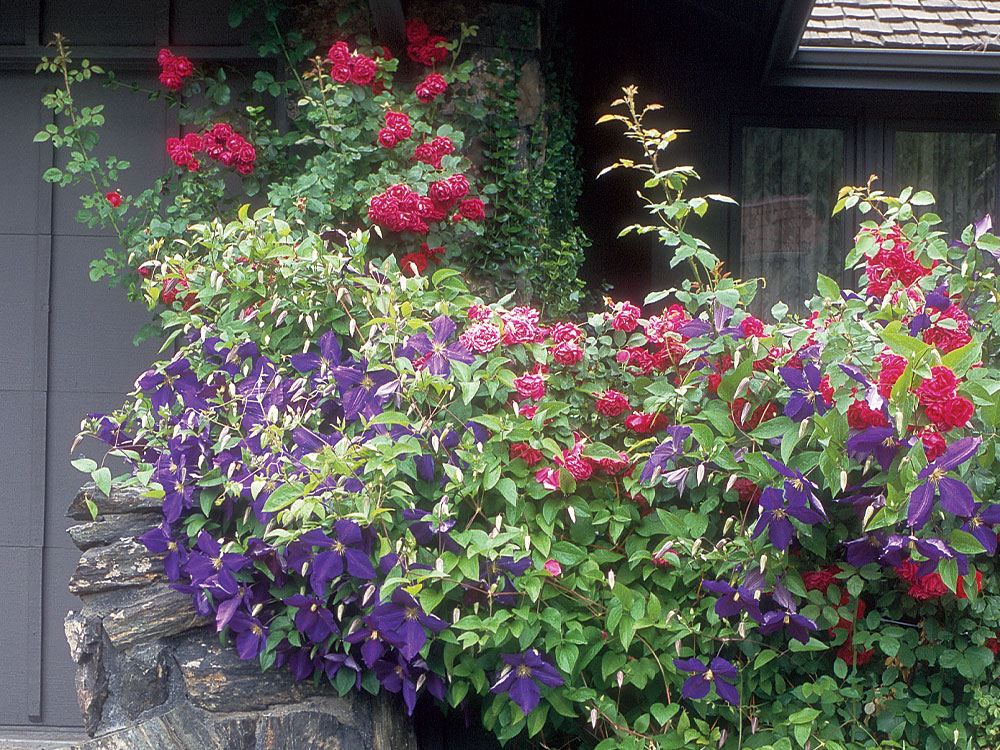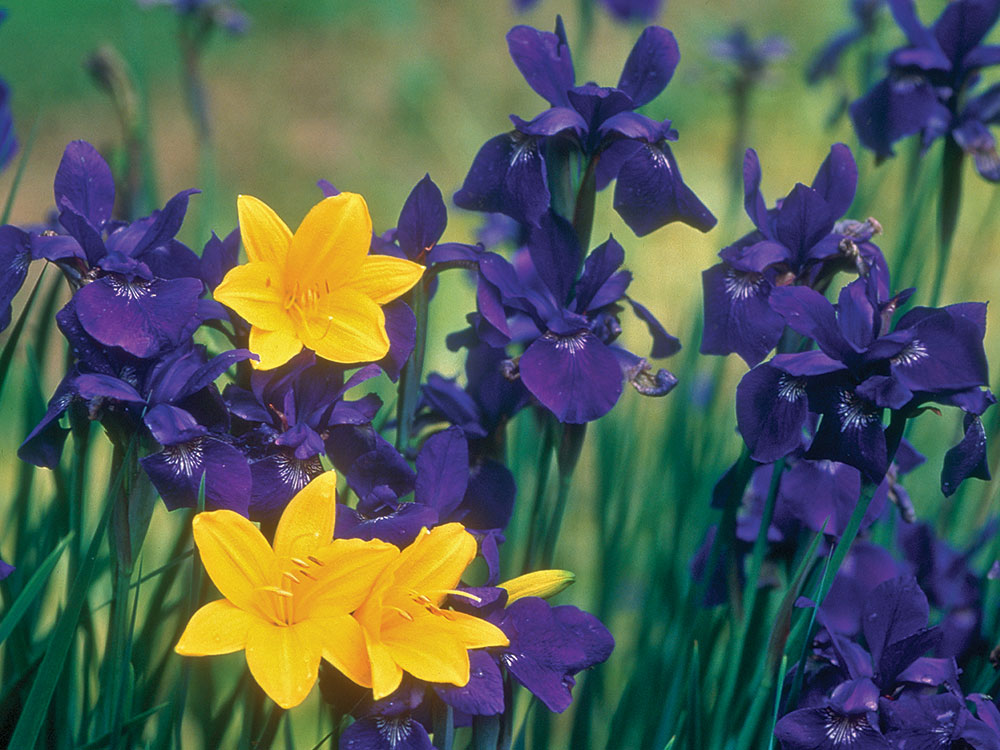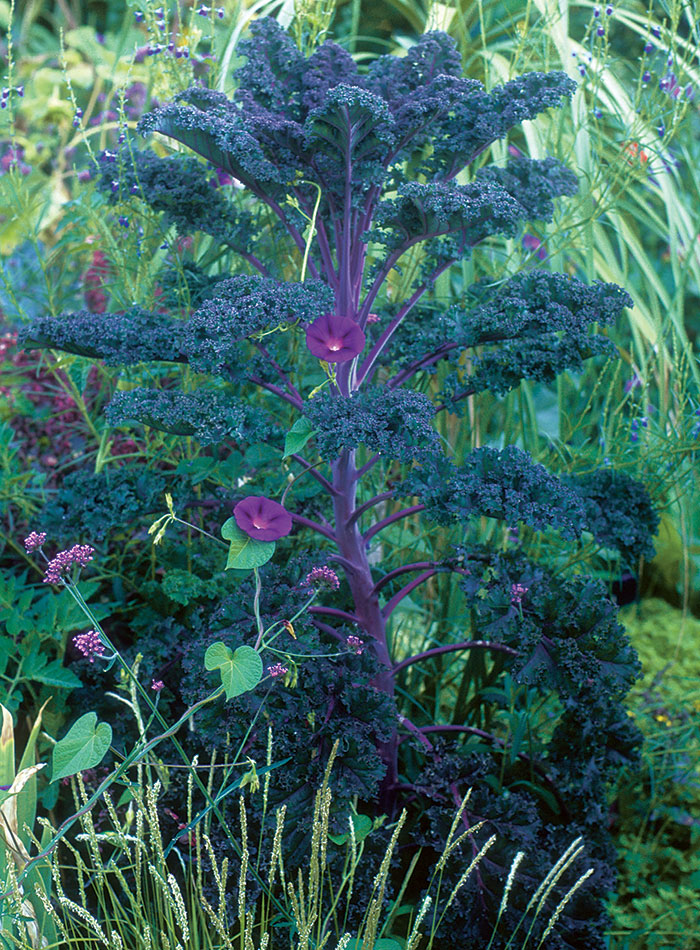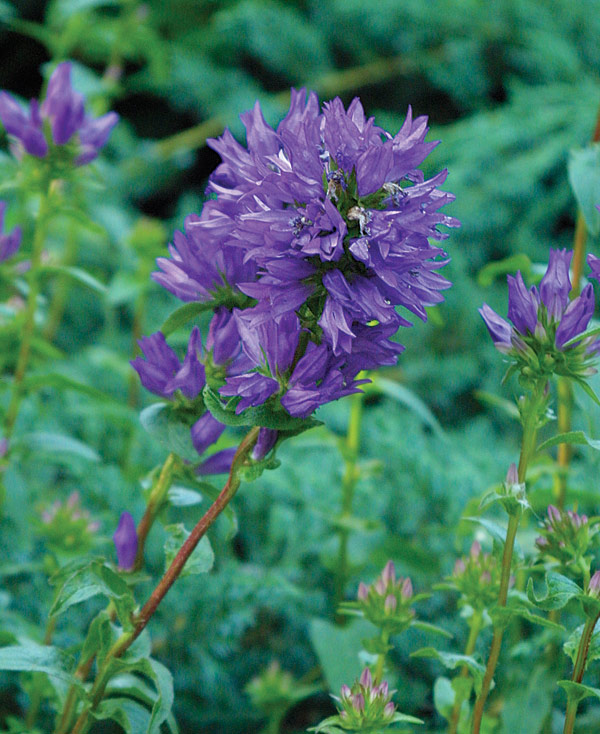
Purple is a hue both rare and renowned in natural and human history. Scarcity earned it a regal quality, as only kings and queens could afford to possess this color in carpets, tapestries, and clothes. Today, purple is the favorite color of many, including myself and the artist lately known again as Prince, whose song title “Purple Rain” has also become the name of a cultivar of Salvia verticillata. Jimi Hendrix made a deeper horticultural impression with the song “Purple Haze,” which is a cultivar name for plants in at least 10 genera. Despite the color’s popularity in song titles and cultivar names, there continues to be a lot of confusion about what is or is not purple, as well as the best way to include it in the garden.
|
|
|
Many things in the natural world are oddly called purple when they are not. Still more are labeled something else when they truly are that color. Let’s face it, purple-leaved plum is burgundy. Red cabbage and red onion call attention to the misnomer whenever I cut them up in the kitchen, for they are variations of purple. I have a difficult time saying “purple” coneflower, always calling it “pink” instead, which it is. Botanical confusion continues: Violets are purple, not blue, despite what the nursery rhyme tells us; lavender usually blooms purple, although other colors are now available; and lilac, while true to its name, is still called “common purple” in the nursery trade.
A mix of blue and red

In the human world of color wheels and light, it is easy to know purple as one of three secondary colors and the product of the equal mixing of the primary colors red and blue. When the purple mix is heavier on the blue side, the resulting color leans toward indigo. When more red is added to the purple mix, the product is violet. Still more red yields magenta, which is often misnamed purple.

Adding white or black to purple expands the color to new realms. White cools the hue into the sublime and safe pastel range—the lilacs and lavenders. Black darkens it into a shade and deepens its complexity, adding mystery.
Nature seems rather stingy with true purple—there are no purple roses, peonies, or daylilies, for example—yet some gardeners just can’t get enough of the color. It makes sense to understand purple and its variations in order to include it in the garden in ways that yield its fullest potential.

Purple makes a good bedfellow
The rule of thumb for fail-safe color combinations is to keep hues of similar intensity together. Mix jewel-toned colors with royal purple, for example. Blend pastels with the purple tints of lavender or lilac. Earth tones work well with muted dusky purple, which is purple blended with brown. Purple is so versatile that it combines easily with most colors. Following a few guidelines, however, will help you maximize the mood you’re trying to achieve. Keep in mind that purple is a dark hue that can easily be lost if it’s any distance from the viewer; it is best kept up close where it can be appreciated. To keep it alive at a distance, mix dark purple with a high-contrast foil of white or silver.


Primary colors—those that cannot be formed from the mixing of other colors—contrast with purple with increasing vibrancy as one moves along the color wheel from blue to red to yellow. Combining purple and blue seems rich, regal, and sophisticated—cool in more ways than one. Red and purple together are sassy, flashy, and enticingly hot. Yellow, however, makes purple jump. As opposites, or complements, on the color wheel, purple and yellow combine in electric, scintillating ways.
Purple mixes naturally with either of the other two secondary colors, green and orange, and all three together create the traditional festive hues of Mardi Gras. In the garden, there is no shortage of green to complement purple as most plants with purple flowers have green leaves.
Blending pastels—colors to which white has been added—is the mainstay of many a tasteful English-style border. Pastels are safe and comfortable, reminding us of Easter and springtime. The rules for combining colors suggest that a composition of pastels will always succeed. But rules are meant to be broken, and injecting rich purple into a pastel combination is effective. It adds a depth and color complexity that are always satisfying. Dark blue, too, can spice up a pastel planting without upsetting the genteel flavor intended.


Of all the colors that combine well with purple perhaps the best is more purple. This is not just a reiteration of my favorite axiom, “Too much of a good thing is great.” The varied hues of purple in nature yield so many different but similar colors that the resulting garden mélange is vividly effective. Even the pastel shades of lavender and lilac mingle well with royal purple, violet, and indigo. To successfully incorporate even more of this rich color in your beds and borders, be sure to add plants with deep purple foliage such as Persian shield (Strobilanthes dyerianus, USDA Hardiness Zones 9–11) or purple heart (Tradescantia pallida ‘Purple Heart’, Zones 8–11).
Following these simple rules should make it easier to design with purple. But clearing up popular confusion about the color is another matter. Consider the opening scene of the movie The Color Purple, in which the leading lady runs through a field of blooming cosmos, waxing enthusiastic about purple and yet the flowers are not that color at all but rather magenta-pink. I propose that when they remake the movie they replace the cosmos with verbena or salvia or tall asters. Any plant, in other words, that is purely purple.
Magenta: When purple sees red

Magenta is the red-headed stepchild of purple. Many people consider magenta-hued flowers to be in league with purple, but magenta is on the red side of violet and in a class all its own. It is readily found in flowers such as winecups (Callirhoe involucrata, Zones 4–9), rose campion (Lychnis coronaria, Zones 3–8), bloody cranesbill (Geranium sanguineum, Zones 3–8), cosmos (Cosmos bipinnatus cvs., annual), fireweed (Epilobium angustifolium, Zones 3–7), perennial pea (Lathyrus latifolius, Zones 5–9), and loosestrife—yes, the “purple” one (Lythrum salicaria, Zones 4–9).
The color has combination qualities that elude purple. Magenta looks stunning with the silver foliage of lambs’ ears (Stachys byzantina, Zones 4–8), artemisia (Artemisia spp. and cvs., Zones 3–9), and silver sage (Salvia argentea, Zones 5–8). Magenta-hued flowers are always effectively contrasted with soft yellow blooms, including those of ‘Moonshine’ yarrow (Achillea ‘Moonshine’, Zones 3–8) and ‘Moonbeam’ coreopsis (Coreopsis verticillata ‘Moonbeam’, Zones 3–8). Magenta also contrasts smartly with green, which perhaps explains why magenta appears so widely in the natural world.
A sampling of purples
- Bearded irises (Iris spp. and cvs., Zones 3–9), all shades
- Petunias (Petunia spp. and cvs., annual), all shades
- Siberian irises (Iris spp. and cvs., Zones 3–9), violet, violet purple, royal purple
- Purple heart (Tradescantia pallida ‘Purple Heart’, Zones 8–11), violet purple
- Purple wood sorrel (Oxalis regnellii ‘Triangularis’ and ‘Francis’, Zones 7–10), violet purple
- Canterbury bells (Campanula medium and cvs., Zones 5–8), royal purple
- Clustered bellflowers (Campanula glomerata and cvs., Zones 3–8), royal purple
- Corsican violet (Viola corsica, Zones 4–9), royal purple
- English lavenders (Lavandula angustifolia ‘Mitcham Gray’ and ‘Hidcote’, Zones 5–8), royal purple
- Glory bush (Tibouchina urvilleana, Zones 9–11), royal purple
- Jackman clematis (Clematis ‘Jackmanii’, Zones 4–11), royal purple
- New England asters (Aster novae-angliae ‘Purple Dome’ and ‘Hella Lacey’, Zones 4–8), royal purple
- Persian shield (Strobilanthes dyerianus, Zones 9–11), royal purple
- Rocky Mountain beard-tongue (Penstemon strictus, Zones 3–8), royal purple
- Rose vervain (Verbena canadensis ‘Homestead Purple’, Zones 5–9), royal purple
- Salvias (Salvia × superba and cvs., Zones 5–9), royal purple
- Butterfly bush (Buddleia davidii ‘Black Knight’, Zones 6–9), dark purple
- ‘Indigo Spires’ salvia (Salvia ‘Indigo Spires’, Zones 8–11), indigo
- ‘May Night’ salvia (Salvia × sylvestris ‘May Night’, Zones 5–9), indigo
Tom Peace is a contributing editor who divides his time between Texas and Colorado. He shares a birth date with Prince.
All photos, except where noted: Tom Peace
Fine Gardening Recommended Products

Buffalo-Style Gardens: Create a Quirky, One-of-a-Kind Private Garden with Eye-Catching Designs
Fine Gardening receives a commission for items purchased through links on this site, including Amazon Associates and other affiliate advertising programs.

Gardener's Log Book from NYBG
Fine Gardening receives a commission for items purchased through links on this site, including Amazon Associates and other affiliate advertising programs.

The Crevice Garden: How to make the perfect home for plants from rocky places
Fine Gardening receives a commission for items purchased through links on this site, including Amazon Associates and other affiliate advertising programs.


























Comments
my stepmum just purchased Mercedes GL-Class GL63 AMG by working part time off of a computer... read this articlehttp://www.jump62.com ">EASIEST WORK!
Log in or create an account to post a comment.
Sign up Log in